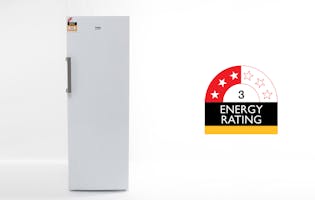Fridges
Find the best fridge for your home with our buying guide and test results for 77 new and 140 discontinued models.
Our expert testers assess the latest fridge-freezers for temperature fluctuations, uniformity between the fridge and freezer, and much more.
Choosing which models to test
As much as we’d love to, we can’t test every fridge and fridge-freezer on the market. Testing is expensive and time consuming, and we have a limited budget.
Instead, we regularly survey the market, and discuss with manufacturers which models will be deleted, which are staying current and what new models will be released in the near future. We then choose a representative selection of models for testing, including both cheaper and more expensive ones, top and bottom mount, side-by-side and French door, as well as any models with new or interesting features.
If you don’t see the model you’re considering purchasing in our test results, then try and identify a similar model by the same manufacturer, and pay attention to our reliability and satisfaction results – if you choose a brand that scores highly you’ll likely end up with a good model, that will also last you a long time.
Lifetime score
Our overall score combines test performance (how well the appliance works) with predicted reliability (how likely models from the brand are to remain free of faults) and brand satisfaction (how likely owners of the brand are to be very satisfied with their appliance).
 We’ll only recommend appliances you’ll love to own, that work well and keep working well for a long time.
We’ll only recommend appliances you’ll love to own, that work well and keep working well for a long time.
Test performance

It’s no good if a product lasts for several decades if it doesn’t work well in the first place. A disappointing product will soon become unloved and unwanted. For this reason, our independent lab testing forms an important part of our overall lifetime score.
Our overall score is made up of the following.
Food safety
Temperature fluctuations
We measure how much the temperature inside the fridge fluctuates (or swings) as the compressor starts and stops. The higher the score, the less the temperature changes.
Temperature uniformity
We measure how uniform the temperature is throughout each compartment. The higher the score, the more uniform the temperature is in the fridge and the freezer compartments.
Seasonal change effect
We test how well the appliance deals with changing temperatures outside. We test in a temperature-controlled room. We adjust the temperatures to simulate winter and summer conditions while monitoring the temperature inside the fridge. The higher the score, the better the fridge deals with temperature changes, meaning it will need less adjustments throughout the seasons.

Temperature control
Heat-load test (new test)
This test shows how powerful the fridge is by measuring the time taken and energy used for temperatures inside to reach an even state after room-temperature food has been placed into it. The heat-load test is also an indication of how efficient the fridge is. This is a new test, replacing the older temperature combinations test.
Temperature combinations (old test)
We measure the temperature in the fridge and freezer compartments at the same time. A high score means the temperatures in both compartments are managed well – for example, if the freezer is set to its coldest setting, the temperature in the fridge isn’t affected. This is an older test and has now been replaced by the heat-load test.
Once all the models have been tested with the new heat-load test, this test will be removed from our results.
Default settings
A test of how well the fridge performs on the manufacturer's recommended settings. Many people will only change the temperature setting once, so we test with the recommended settings. If there isn’t a recommended setting, we test using the factory set or mid-setting.

Predicted reliability
It’s reasonable to expect a new appliance to remain fault-free for at least the first 5 years. Our predicted reliability won’t tell you whether the fridge in your laundry will spring a leak tomorrow, but it does show which brands make models that are less likely to fail.
Brand satisfaction
Satisfaction is important – no appliance should be a source of buyer regret. Appliances with very satisfied owners are more likely to get cleaned regularly and maintained well. Their owners are also more likely to seek repair for faults than look for a quick replacement.
Survey data
In our annual reliability and satisfaction survey, consumers tell us about faults that have left an appliance they own unusable or mean they’ve had to change how they use it. We also ask them how satisfied they are with the appliance. We use this data to produce our predicted reliability and brand satisfaction scores.
We use a statistical test to rate the relative performance of each brand. Compared to data we have for all products (of the same type) in the survey, we rate each brand with highest, high, average, low or lowest reliability and satisfaction. You can compare the ratings for different brands of the same product type (for example, the reliability rating for Samsung and Fisher & Paykel fridges), but you can’t compare the results for different product types (for example, satisfaction of LG TVs and Samsung phones).
We analyse brands that get at least 30 responses in our survey. That means there are some brands we can’t analyse because we don’t have enough data. For those brands, we assume they have average predicted reliability and brand satisfaction.
Our data is based on responses for 3,169 fridges, fridge-freezers and freezers in our 2023 survey.
We've tested 217 fridges.
Find the right one for you.
Beko

Bosch
.jpg&w=315&q=75)
Bosch
.jpg&w=315&q=75)